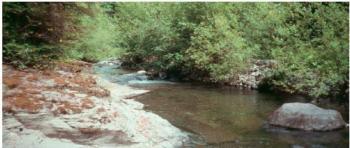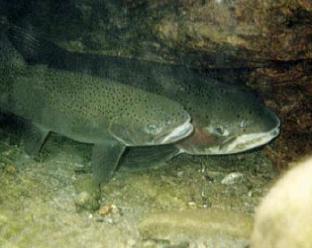Forest Streams

Stream Channels
Stream channels form as a means of transporting water, sediment and wood from forested headwaters downhill. Channels develop and wildlife has evolved to adapt to this dynamic environment. Many forest streams have been impaired by previous practices including dredging, dams, straightening, mining, and road crossings. Currently, modification of stream channels is heavily regulated in California, but many legacy impacts exist that can be mitigated by stream management practices or active restoration.
| For more information on maintaining health forest streams, please see the UCCE publication: Forest Stewardship Series 9 Forest Streams. |
Riparian Vegetation
A key to maintaining healthy stream channels is to protect and enhance the riparian vegetation growing along it. Riparian vegetation performs important ecological functions including serving as terrestrial and aquatic habitat, stabilizing stream banks, providing shade and large woody debris that adds complexity to stream beds to improve fish habitat. Removal of this vegetation can trigger degradation and instability of streams leading to erosion and washing away of stream side property. Maintenance of buffer strips where no development occurs next to stream channels is one of the best ways to protect riparian vegetation and is required when many projects including timber harvest are done.
| For more information on how to maintain or improve riparian vegetation along forest streams, please see the UCCE publication: Forest Stewardship Series 10 Riparian Vegetation. |
Water Quality
Since forest management and other land use activities have impacts on water quality, it is important to understand what water quality is, how it is measured and how to protect it. The quality of water coming from forest lands is vital for human use, but also for sustaining aquatic life, irrigation, swimming and recreation, navigation and hydropower generation. Water quality indicators include clarity (turbidity), chemical content (pesticides, nutrients, petroleum products etc), bacterial content and temperature (in relation to the tolerance levels of aquatic organisms).
| Best management practices to maintain water quality in forested streams are listed in this UCCE publication: Forest Stewardship Series 11 Forest Water Quality. |
Fish and Fish Habitat

| For more information on how to protect and restore fish habitat, please see UCCE publication: Forest Stewardship Series 12 Fish and Fish Habitat. |
More Resources
UC Resources
Riparian Forest Habitat and Vegetation Management Webinar (2024) This UC ANR Forest Stewardship special session provides an overview of riparian habitat ecology and values; rules and regulations for management in riparian zones; and assistance for forest landowners.
Papers and Guides
- A Visual Assessment of Riparian Health: Rangeland Monitoring Series (download)
- Developing a Monitoring Program for Riparian Revegetation Projects (download)
- Maintaining Wood in Streams: A Vital Action for Fish Conservation (download)
- Sediment Inventory and Monitoring: A Method for Water Quality Management in Rangeland Watersheds (download)
- Fish Habitat in Freshwater Streams. (download)
- Living Among the Fish: A Guide to Conserving Fish Habitat in the Developed Landscape. (download)
Other Resources
- Myriad Benefits of Mountain Meadows, Forestland Steward Newsletter 2011, Placer Resource Conservation District
